WTO补贴与反补贴协议AGREEMENT ON SUBSIDIES AND COUNTERVAILING MEASURES
- 格式:pdf
- 大小:230.88 KB
- 文档页数:44
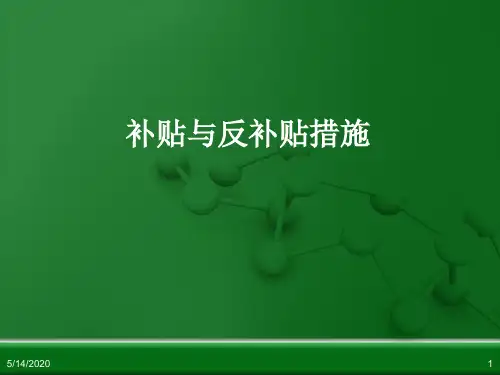
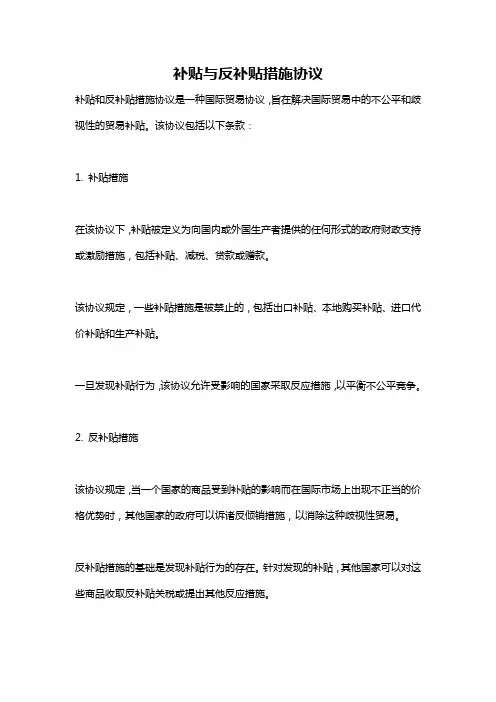
补贴与反补贴措施协议
补贴和反补贴措施协议是一种国际贸易协议,旨在解决国际贸易中的不公平和歧视性的贸易补贴。
该协议包括以下条款:
1. 补贴措施
在该协议下,补贴被定义为向国内或外国生产者提供的任何形式的政府财政支持或激励措施,包括补贴、减税、贷款或赠款。
该协议规定,一些补贴措施是被禁止的,包括出口补贴、本地购买补贴、进口代价补贴和生产补贴。
一旦发现补贴行为,该协议允许受影响的国家采取反应措施,以平衡不公平竞争。
2. 反补贴措施
该协议规定,当一个国家的商品受到补贴的影响而在国际市场上出现不正当的价格优势时,其他国家的政府可以诉诸反倾销措施,以消除这种歧视性贸易。
反补贴措施的基础是发现补贴行为的存在。
针对发现的补贴,其他国家可以对这些商品收取反补贴关税或提出其他反应措施。
在实践中,补贴和反补贴措施的使用通常是谨慎的,因为它们可能导致国际贸易关系的剧烈变化。
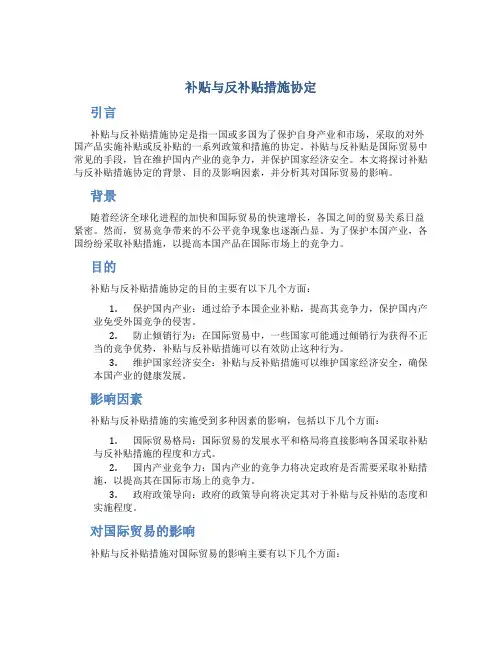
补贴与反补贴措施协定引言补贴与反补贴措施协定是指一国或多国为了保护自身产业和市场,采取的对外国产品实施补贴或反补贴的一系列政策和措施的协定。
补贴与反补贴是国际贸易中常见的手段,旨在维护国内产业的竞争力,并保护国家经济安全。
本文将探讨补贴与反补贴措施协定的背景、目的及影响因素,并分析其对国际贸易的影响。
背景随着经济全球化进程的加快和国际贸易的快速增长,各国之间的贸易关系日益紧密。
然而,贸易竞争带来的不公平竞争现象也逐渐凸显。
为了保护本国产业,各国纷纷采取补贴措施,以提高本国产品在国际市场上的竞争力。
目的补贴与反补贴措施协定的目的主要有以下几个方面:1.保护国内产业:通过给予本国企业补贴,提高其竞争力,保护国内产业免受外国竞争的侵害。
2.防止倾销行为:在国际贸易中,一些国家可能通过倾销行为获得不正当的竞争优势,补贴与反补贴措施可以有效防止这种行为。
3.维护国家经济安全:补贴与反补贴措施可以维护国家经济安全,确保本国产业的健康发展。
影响因素补贴与反补贴措施的实施受到多种因素的影响,包括以下几个方面:1.国际贸易格局:国际贸易的发展水平和格局将直接影响各国采取补贴与反补贴措施的程度和方式。
2.国内产业竞争力:国内产业的竞争力将决定政府是否需要采取补贴措施,以提高其在国际市场上的竞争力。
3.政府政策导向:政府的政策导向将决定其对于补贴与反补贴的态度和实施程度。
对国际贸易的影响补贴与反补贴措施对国际贸易的影响主要有以下几个方面:1.贸易壁垒加大:补贴与反补贴措施的实施将加大国际贸易的壁垒,增加了国内产业准入的门槛。
2.贸易纠纷增加:由于补贴与反补贴措施的实施,导致贸易争端和纠纷的增加,进而影响国际贸易的稳定性。
3.扭曲市场竞争:补贴与反补贴措施可能扭曲市场竞争,使市场资源分配不均衡。
结论补贴与反补贴措施协定在保护国内产业和维护国家经济安全方面发挥着重要作用。
然而,其实施也带来了一系列的负面影响。
为了实现国际贸易的公平与自由,各国应加强沟通与协调,制定更为合理和有效的补贴与反补贴措施,以实现共赢的局面。
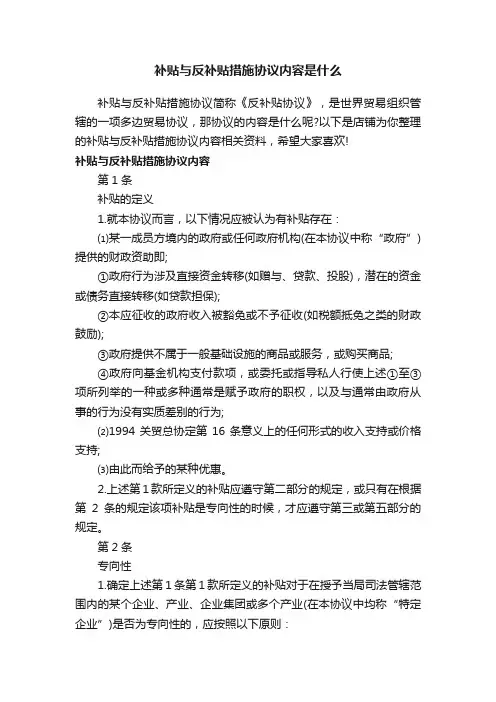
补贴与反补贴措施协议内容是什么补贴与反补贴措施协议简称《反补贴协议》,是世界贸易组织管辖的一项多边贸易协议,那协议的内容是什么呢?以下是店铺为你整理的补贴与反补贴措施协议内容相关资料,希望大家喜欢!补贴与反补贴措施协议内容第1条补贴的定义1.就本协议而言,以下情况应被认为有补贴存在:⑴某一成员方境内的政府或任何政府机构(在本协议中称“政府”)提供的财政资助即;①政府行为涉及直接资金转移(如赠与、贷款、投股),潜在的资金或债务直接转移(如贷款担保);②本应征收的政府收入被豁免或不予征收(如税额抵免之类的财政鼓励);③政府提供不属于一般基础设施的商品或服务,或购买商品;④政府向基金机构支付款项,或委托或指导私人行使上述①至③项所列举的一种或多种通常是赋予政府的职权,以及与通常由政府从事的行为没有实质差别的行为;⑵1994关贸总协定第16条意义上的任何形式的收入支持或价格支持;⑶由此而给予的某种优惠。
2.上述第1款所定义的补贴应遵守第二部分的规定,或只有在根据第2条的规定该项补贴是专向性的时候,才应遵守第三或第五部分的规定。
第2条专向性1.确定上述第1条第1款所定义的补贴对于在授予当局司法管辖范围内的某个企业、产业、企业集团或多个产业(在本协议中均称“特定企业”)是否为专向性的,应按照以下原则:⑴如果补贴授予当局或该当局据以行动的立法将补贴的获得明确限于特定企业,这种补贴即具有专向性。
⑵如果补贴授予当局或当局据以行动的立法对获得补贴的资格和数额规定了客观的标准或条件,如能严格遵守这些标准和条件,并且一旦符合便能自动获得补贴,则该补贴不具有专向性。
有关的标准或条件必须在法律、规章或其他官方文件中明确写明,以便能够对其加以核实。
⑶如果尽管上述⑴和⑵项所规定原则的适用表现为非专向性,但有理由使人相信其实际上具有专向性,则应考虑其他的因素。
这些因素包括:补贴计划由数量有限的特定企业的使用,补贴计划由特定企业支配性的使用,不成比例的大量补贴向特定企业的授予,在决定授予补贴时授予当局行使决断权的方式。
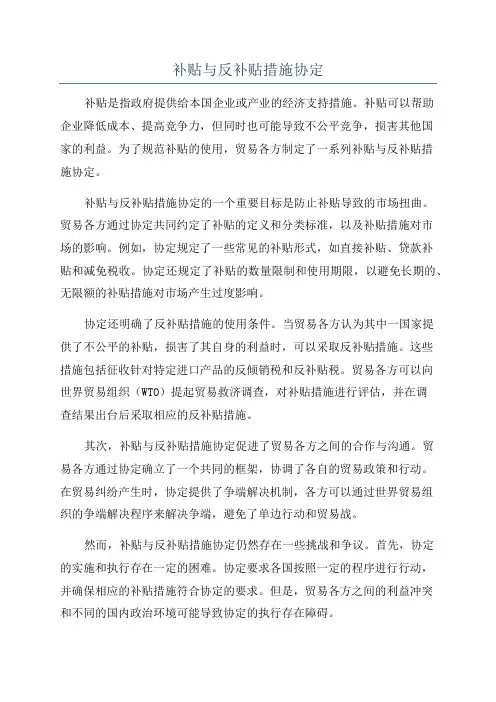
补贴与反补贴措施协定补贴是指政府提供给本国企业或产业的经济支持措施。
补贴可以帮助企业降低成本、提高竞争力,但同时也可能导致不公平竞争,损害其他国家的利益。
为了规范补贴的使用,贸易各方制定了一系列补贴与反补贴措施协定。
补贴与反补贴措施协定的一个重要目标是防止补贴导致的市场扭曲。
贸易各方通过协定共同约定了补贴的定义和分类标准,以及补贴措施对市场的影响。
例如,协定规定了一些常见的补贴形式,如直接补贴、贷款补贴和减免税收。
协定还规定了补贴的数量限制和使用期限,以避免长期的、无限额的补贴措施对市场产生过度影响。
协定还明确了反补贴措施的使用条件。
当贸易各方认为其中一国家提供了不公平的补贴,损害了其自身的利益时,可以采取反补贴措施。
这些措施包括征收针对特定进口产品的反倾销税和反补贴税。
贸易各方可以向世界贸易组织(WTO)提起贸易救济调查,对补贴措施进行评估,并在调查结果出台后采取相应的反补贴措施。
其次,补贴与反补贴措施协定促进了贸易各方之间的合作与沟通。
贸易各方通过协定确立了一个共同的框架,协调了各自的贸易政策和行动。
在贸易纠纷产生时,协定提供了争端解决机制,各方可以通过世界贸易组织的争端解决程序来解决争端,避免了单边行动和贸易战。
然而,补贴与反补贴措施协定仍然存在一些挑战和争议。
首先,协定的实施和执行存在一定的困难。
协定要求各国按照一定的程序进行行动,并确保相应的补贴措施符合协定的要求。
但是,贸易各方之间的利益冲突和不同的国内政治环境可能导致协定的执行存在障碍。
其次,补贴与反补贴措施协定可能给一些发展中国家带来不利影响。
这些国家通常依靠补贴来发展自己的经济和产业。
限制补贴可能会导致这些国家的产业竞争力下降,进一步加剧了贸易不平衡。
综上所述,补贴与反补贴措施协定对国际贸易起到了重要的规范和调节作用。
它保护了贸易的公平性,促进了贸易各方之间的合作与沟通。
然而,协定的执行和实施仍然存在障碍,需要各方共同努力,以实现更加公平、公正和可持续的国际贸易体系。
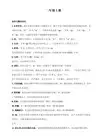
反倾销、反补贴、保障和特殊情况处理等(中英文对照)Anti-dumping, Subsidies, Safeguards,Contingencies, etc反倾销、反补贴、保障和特殊情况处理等英文来源:/english/thewto_e/whatis_e/tif_e/agrm8_e.htmBinding tariffs, and applying them equally to all trading partners (most-favoured-nation treatment, or MFN) are key to the smooth flow of trade in goods.约束关税及将其在全体贸易成员国之间平等地适用(即最惠国待遇,简称MFN)是保证商品交易过程畅通的关键。
The WTO agreementsuphold the principles, but they also allow exceptions — in some circumstances. Three of these issues are:世贸协议秉持着这些原则,但有时也有例外。
例如以下三种情况:actions taken against dumping (selling at an unfairly low price)1.反倾销(以不公平的低价出售商品的行为)措施;subsidies and special “countervailing” duties to offset the subsidies1.贸易补贴以及为抵消贸易补贴而征收的“反补贴”关税;emergency measures to limit imports temporarily, d esigned to “safeguard”domestic industries.1.为暂时限制进口以“保护”国内产业而采取的紧急应对措施。
Anti-dumping actions反倾销措施If a company exports a product at a price lower than the price it normally charges on its own home market, it is said to be “dumping” the product.如果某一公司以低于其在国内市场正常出售的价格出口某一产品,我们就称其“倾销”该产品。
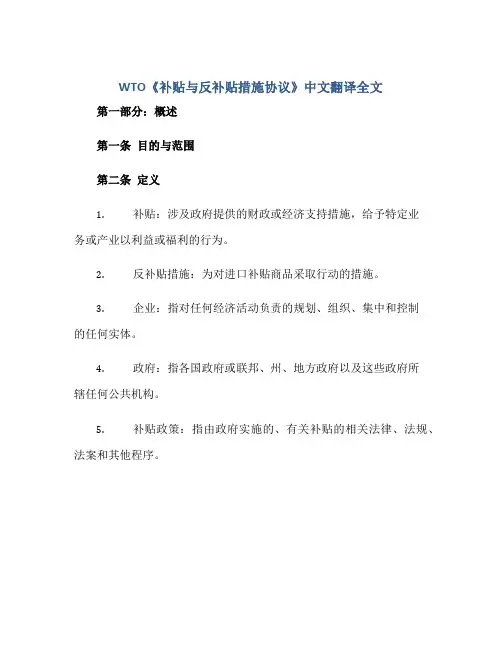
WTO《补贴与反补贴措施协议》中文翻译全文第一部分:概述第一条目的与范围第二条定义1.补贴:涉及政府提供的财政或经济支持措施,给予特定业务或产业以利益或福利的行为。
2.反补贴措施:为对进口补贴商品采取行动的措施。
3.企业:指对任何经济活动负责的规划、组织、集中和控制的任何实体。
4.政府:指各国政府或联邦、州、地方政府以及这些政府所辖任何公共机构。
5.补贴政策:指由政府实施的、有关补贴的相关法律、法规、法案和其他程序。
第二部分:补贴措施第三条补贴的性质补贴可以是直接支付的款项,包括政府赠款或贷款,以及政府提供的资金;或者是通过减免税收或特殊贷款条件等间接给予的经济支持。
第四条禁止的补贴措施1.对出口者或者特定商品的支付国内补贴。
2.鼓励产生、使用或者接受特定出口而支付的补贴。
3.对本国采购的特定商品支付的补贴。
4.补贴的支付与出口性质或者程度直接相关。
5.其他补贴措施,使产品在全球市场上得到不正当竞争优势。
第五条非禁止补贴措施本协议规定的禁止补贴措施以外的补贴措施被认为为非禁止补贴措施。
这些补贴措施可能带有一定的负面影响,但不被禁止。
第六条有害补贴如果另一WTO成员认为另一成员国的某种补贴对本国国内产业造成了实质损害,可以要求所涉及的补贴所属成员实施或维持的补贴措施符合本协议的规定。
第三部分:反补贴措施第七条损害证据和因果关系的确定采取反补贴措施之前,首先应当确立所涉及的补贴对本国产业造成了实质性损害,并确定补贴与损害之间的因果关系。
第八条临时反补贴如果经过初步调查,存在足够证据表明所涉及的进口商品得到了补贴支持,调查成员可以立即采取临时反补贴措施。
第九条临时反补贴措施的暂停如果最终调查发现实质上未发生补贴,或者存在其他证据证明补贴或其支付无法正式证明,成员应立即暂停临时反补贴措施。
第十条对进口商品的反补贴措施在调查发现进口商品得到了补贴支持,并对本国产业造成了实质性损害的情况下,成员可以采取正式的反补贴措施。
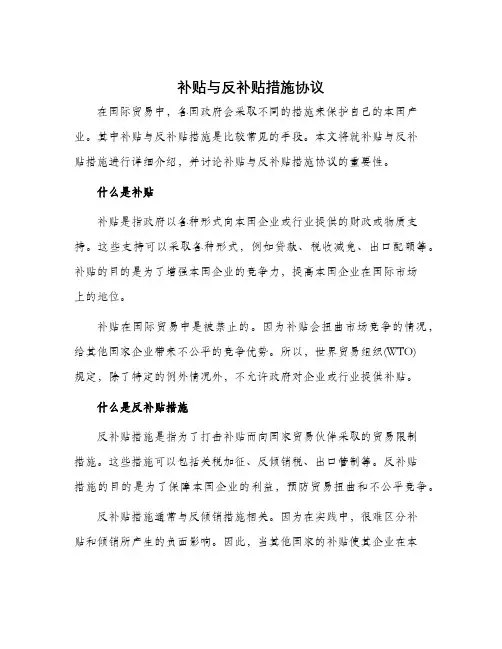
补贴与反补贴措施协议在国际贸易中,各国政府会采取不同的措施来保护自己的本国产业。
其中补贴与反补贴措施是比较常见的手段。
本文将就补贴与反补贴措施进行详细介绍,并讨论补贴与反补贴措施协议的重要性。
什么是补贴补贴是指政府以各种形式向本国企业或行业提供的财政或物质支持。
这些支持可以采取各种形式,例如贷款、税收减免、出口配额等。
补贴的目的是为了增强本国企业的竞争力,提高本国企业在国际市场上的地位。
补贴在国际贸易中是被禁止的。
因为补贴会扭曲市场竞争的情况,给其他国家企业带来不公平的竞争优势。
所以,世界贸易组织(WTO)规定,除了特定的例外情况外,不允许政府对企业或行业提供补贴。
什么是反补贴措施反补贴措施是指为了打击补贴而向国家贸易伙伴采取的贸易限制措施。
这些措施可以包括关税加征、反倾销税、出口管制等。
反补贴措施的目的是为了保障本国企业的利益,预防贸易扭曲和不公平竞争。
反补贴措施通常与反倾销措施相关。
因为在实践中,很难区分补贴和倾销所产生的负面影响。
因此,当其他国家的补贴使其企业在本国市场上价格更低时,受影响的国家往往会对这些商品采取反倾销措施。
为什么补贴与反补贴措施协议重要由于补贴和反补贴措施会扭曲国际贸易的市场竞争情况,故很多国家都认为有必要制定相应的协议,以便在发生贸易纠纷时可以迅速、有效地解决争端。
补贴与反补贴措施协议在国际贸易中具有重要作用。
首先,它为各国提供了制定贸易规则的机制。
协议规定了补贴多少可以被允许、哪些措施可以用来反驳补贴、以及如何在互动中实行这些措施。
其次,该协议还包括了成员间解决补贴和反补贴措施争端的统一程序。
该机制为争端解决创建了相关规则和流程,并且允许任何提供信息的成员参与到解决争端过程中。
这些规则和流程使得争端处理变得更加公正、透明、高效。
最后,该协议还为各国提供了一个解决商业问题的机会。
补贴和反补贴措施协议并不是一种宽松的机制,但它为各国解决未来的贸易问题提供了一个机会。
如果一方认为自己受到了另一方的不公平待遇,那么双方将有机会通过协议维护各自的利益。
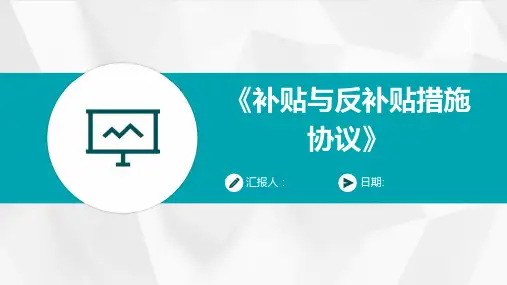
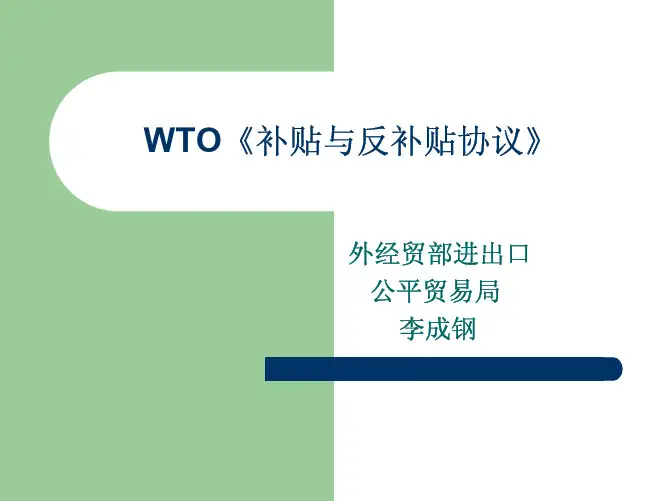
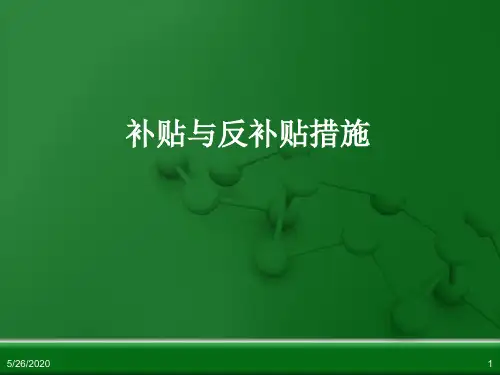
专业合同封面COUNTRACT COVER20XXP ERSONAL甲方:XXX乙方:XXX2024版世界贸易组织补贴和反补贴协定本合同目录一览1. 定义与术语1.1 合同主体1.2 补贴1.3 反补贴1.4 世界贸易组织2. 补贴的种类2.1 直接补贴2.2 间接补贴2.3 条件性补贴2.4 其他形式的补贴3. 反补贴的措施3.1 反补贴调查3.2 反补贴税3.3 价格承诺3.4 取消补贴4. 补贴和反补贴的适用范围4.1 适用产品4.2 适用国家或地区4.3 例外情况5. 争端解决机制5.1 协商解决5.2 调解5.3 仲裁5.4 世界贸易组织争端解决机构6. 合同的生效、修改和终止6.1 生效条件6.2 修改程序6.3 终止条件7. 合同的解释和适用法律7.1 合同解释7.2 适用法律8. 合同的履行和监督8.1 履行义务8.2 监督和检查9. 违约责任9.1 违约行为9.2 违约责任9.3 违约解决方式10. 保密条款10.1 保密信息10.2 保密义务10.3 例外情况11. 不可抗力11.1 不可抗力事件11.2 不可抗力后果11.3 不可抗力通知和证明12. 争议解决12.1 争议类型12.2 争议解决方式12.3 争议解决地点和机构13. 合同的终止和解除13.1 终止条件13.2 解除程序13.3 终止或解除后的权利和义务14. 一般条款14.1 通知14.2 完整的协议14.3 合同的转让14.4 适用语言14.5 合同的修订日期第一部分:合同如下:1. 定义与术语1.1 合同主体1.2 补贴补贴是指一方(补贴提供方)向另一方(受补贴方)提供财政资助,或者提供除财政资助以外的任何形式的收入或者价格支持,导致受补贴方的出口或者进口在数量上增加。
1.3 反补贴反补贴是指进口国对于接受补贴的出口商品采取的一种反制措施,旨在消除或者减少补贴对进口国产业造成的损害。
1.4 世界贸易组织世界贸易组织(World T rade O rganization,WTO)是负责监督国际贸易规则的国际组织,其目标是促进国际贸易的自由化和公平化。
《补贴与反补贴措施协议》1.协议背景本协议旨在规定补贴与反补贴措施的相关事宜,旨在促进公平竞争和国际贸易的健康发展。
2.补贴措施2.1补贴范围(1)本协议所指的补贴是指任何形式的直接或间接财政拨款、税收减免、贷款担保、直接或间接宝倫消费的价格补贴、政府担保或不计入进口物理的计量费用等等;(2)补贴涉及的领域包括但不限于农业、能源、运输、制造业、服务业等。
2.2补贴限制(1)各成员应遵守《世界贸易组织协议》中关于补贴的规定;(2)各成员对本国企业的补贴应公开透明,确保公平竞争环境;(3)各成员不得采取任何旨在扭曲国内市场竞争和干扰其他成员贸易的补贴措施;(4)各成员不得采取任何旨在阻碍其他成员企业进入本市场的补贴措施。
2.3补贴申报与报告(1)各成员应及时向世界贸易组织通报有关补贴的信息,确保信息透明度;(2)申请补贴的企业应遵守世界贸易组织的相关规定,并提交相关证明材料和报告。
3.反补贴措施3.1反补贴调查(1)各成员有权对其他成员实施的补贴措施进行调查,以确认是否存在违反协议的行为;(2)反补贴调查应遵循公平、透明、无歧视的原则。
3.2反补贴措施的实施(1)如果经反补贴调查确认存在违反协议的行为,各成员可以采取合理和必要的措施予以反制;(2)反补贴措施应符合世界贸易组织规定,并尽量避免对其他成员的不合理歧视和损害。
3.3反补贴结果的宣告和通报(1)反补贴调查结果应及时宣告并通报世界贸易组织;(2)各成员应对反补贴措施的实施进行监测和评估,并向世界贸易组织通报相关信息。
4.争端解决各成员在实施补贴和反补贴措施中发生争议时,应通过友好协商解决。
如果协商不能解决争端,各成员可以向世界贸易组织争端解决机制寻求调解、仲裁或争端解决。
5.协议执行和监督5.1协议签署后,各成员应按照约定执行,并建立相应的内部机制监督协议的实施情况。
5.2各成员需定期向世界贸易组织报告实施补贴与反补贴措施的情况,包括补贴的类型、金额和受益方,并提供相关的证明材料。
WTO补贴与反补贴与政府公共政策WTO补贴与反补贴措施与政府公共政策扶持第一部分问题的提出一、“广交会”的改名(“外需拉动型”经济政策的反思和痛苦转型)二、方正IC生产线深圳投产(政府对产业补贴)三、中国在WTO被诉第一案——“集成电路产业政策”案(国际法层面)四、加拿大政府针对中国产品的反补贴系列案件(国内法层面)第二部分问题的分析一、补贴与反补贴措施概述补贴与反补贴措施(Subsidy and Counter-veiling Measures),简称SCM。
1、补贴(Subsidy)的概念——广义、狭义所谓补贴,广义上讲可以指政府各种财政政策。
因为对现代国家政府而言,负有协调社会方方面面均衡发展的职能,而政府履行社会管理者职能的重要手段就是财政政策。
特别是二战后,凯恩斯主义的盛行,福利国家的兴起,各个国家政府的补贴行为可以说非常普遍,往往是兼顾经济与社会福利乃至非经济因素,例如对贫困落后地区的“扶贫补贴”,为拯救民族文化的补贴,对残疾人的补贴等等。
一个国家政府在基础能源、通讯方面投入的财政补贴,甚至国家对于基础科学研究、教育、医疗卫生等等领域的投资,乃至政府用于社会治安、法律的执行、社会保障等等方面的经费,最后都会降低企业的生产成本和交易成本,这些费用实际上都要“内化”到产品成本中。
从狭义上讲,补贴可以单指政府出于执行其政策或者经济政策的考虑,对一个或一些企业或者一种或一类产品以利益的行为。
根据WTO协议,补贴(subsidies)是指一成员政府或任何公共机构(any public body)向某一企业或某一产业提供财政捐助(financial cotribution)或对价格或收入的支持,结果直接或间接增加从其领土输出某种产品或减少向其领土内输入某种产品,或者因此对其他成员利益造成损害的政府性行为或措施,是一种促进出口限制进口的国际贸易手段。
1994WTO守则明文把对农产品的补贴问题排除,即另由WTO 《农产品协议》专门作出规定。
AGREEMENT ON SUBSIDIES AND COUNTERVAILING MEASURESMembers hereby agree as follows:PART I: GENERAL PROVISIONSA rticle 1Definition of a Subsidy1.1For the purpose of this Agreement, a subsidy shall be deemed to exist if:(a)(1)there is a financial contribution by a government or any public body within the territoryof a Member (referred to in this Agreement as "government"), i.e. where:(i) a government practice involves a direct transfer of funds (e.g. grants, loans,and equity infusion), potential direct transfers of funds or liabilities (e.g. loanguarantees);(ii)government revenue that is otherwise due is foregone or not collected (e.g.fiscal incentives such as tax credits)1;(iii) a government provides goods or services other than general infrastructure, or purchases goods;(iv) a government makes payments to a funding mechanism, or entrusts or directsa private body to carry out one or more of the type of functions illustrated in(i) to (iii) above which would normally be vested in the government and thepractice, in no real sense, differs from practices normally followed bygovernments;or(a)(2)there is any form of income or price support in the sense of Article XVI of GATT 1994;and(b) a benefit is thereby conferred.1.2 A subsidy as defined in paragraph 1 shall be subject to the provisions of Part II or shall be subject to the provisions of Part III or V only if such a subsidy is specific in accordance with the provisions of Article2.1In accordance with the provisions of Article XVI of GATT 1994 (Note to Article XVI) and the provisions of Annexes I through III of this Agreement, the exemption of an exported product from duties or taxes borne by the like product when destined for domestic consumption, or the remission of such duties or taxes in amounts not in excess of those which have accrued, shall not be deemed to be a subsidy.A rticle 2Specificity2.1In order to determine whether a subsidy, as defined in paragraph 1 of Article 1, is specific to an enterprise or industry or group of enterprises or industries (referred to in this Agreement as "certain enterprises") within the jurisdiction of the granting authority, the following principles shall apply:(a)Where the granting authority, or the legislation pursuant to which the granting authorityoperates, explicitly limits access to a subsidy to certain enterprises, such subsidy shallbe specific.(b)Where the granting authority, or the legislation pursuant to which the granting authorityoperates, establishes objective criteria or conditions2 governing the eligibility for, andthe amount of, a subsidy, specificity shall not exist, provided that the eligibility isautomatic and that such criteria and conditions are strictly adhered to. The criteriaor conditions must be clearly spelled out in law, regulation, or other official document,so as to be capable of verification.(c)If, notwithstanding any appearance of non-specificity resulting from the applicationof the principles laid down in subparagraphs (a) and (b), there are reasons to believethat the subsidy may in fact be specific, other factors may be considered. Such factorsare: use of a subsidy programme by a limited number of certain enterprises, predominantuse by certain enterprises, the granting of disproportionately large amounts of subsidyto certain enterprises, and the manner in which discretion has been exercised by thegranting authority in the decision to grant a subsidy.3 In applying this subparagraph,account shall be taken of the extent of diversification of economic activities withinthe jurisdiction of the granting authority, as well as of the length of time during whichthe subsidy programme has been in operation.2.2 A subsidy which is limited to certain enterprises located within a designated geographical region within the jurisdiction of the granting authority shall be specific. It is understood that the setting or change of generally applicable tax rates by all levels of government entitled to do so shall not be deemed to be a specific subsidy for the purposes of this Agreement.2.3Any subsidy falling under the provisions of Article 3 shall be deemed to be specific.2.4Any determination of specificity under the provisions of this Article shall be clearly substantiated on the basis of positive evidence.2Objective criteria or conditions, as used herein, mean criteria or conditions which are neutral, which do not favour certain enterprises over others, and which are economic in nature and horizontal in application, such as number of employees or size of enterprise.3In this regard, in particular, information on the frequency with which applications for a subsidy are refused or approved and the reasons for such decisions shall be considered.PART II: PROHIBITED SUBSIDIESA rticle 3Prohibition3.1Except as provided in the Agreement on Agriculture, the following subsidies, within the meaning of Article 1, shall be prohibited:(a)subsidies contingent, in law or in fact4, whether solely or as one of several otherconditions, upon export performance, including those illustrated in Annex I5;(b)subsidies contingent, whether solely or as one of several other conditions, upon theuse of domestic over imported goods.3.2 A Member shall neither grant nor maintain subsidies referred to in paragraph 1.A rticle 4Remedies4.1Whenever a Member has reason to believe that a prohibited subsidy is being granted or maintained by another Member, such Member may request consultations with such other Member.4.2 A request for consultations under paragraph 1 shall include a statement of available evidence with regard to the existence and nature of the subsidy in question.4.3Upon request for consultations under paragraph 1, the Member believed to be granting or maintaining the subsidy in question shall enter into such consultations as quickly as possible. The purpose of the consultations shall be to clarify the facts of the situation and to arrive at a mutually agreed solution.4.4If no mutually agreed solution has been reached within 30 days6 of the request for consultations, any Member party to such consultations may refer the matter to the Dispute Settlement Body ("DSB") for the immediate establishment of a panel, unless the DSB decides by consensus not to establish a panel.4.5Upon its establishment, the panel may request the assistance of the Permanent Group of Experts7 (referred to in this Agreement as the "PGE") with regard to whether the measure in question is a prohibited subsidy. If so requested, the PGE shall immediately review the evidence with regard to4This standard is met when the facts demonstrate that the granting of a subsidy, without having been made legally contingent upon export performance, is in fact tied to actual or anticipated exportation or export earnings. The mere fact that a subsidy is granted to enterprises which export shall not for that reason alone be considered to be an export subsidy within the meaning of this provision.5Measures referred to in Annex I as not constituting export subsidies shall not be prohibited under this or any other provision of this Agreement.6Any time-periods mentioned in this Article may be extended by mutual agreement.7As established in Article 24.the existence and nature of the measure in question and shall provide an opportunity for the Member applying or maintaining the measure to demonstrate that the measure in question is not a prohibited subsidy. The PGE shall report its conclusions to the panel within a time-limit determined by the panel. The PGE's conclusions on the issue of whether or not the measure in question is a prohibited subsidy shall be accepted by the panel without modification.4.6The panel shall submit its final report to the parties to the dispute. The report shall be circulated to all Members within 90 days of the date of the composition and the establishment of the panel's terms of reference.4.7If the measure in question is found to be a prohibited subsidy, the panel shall recommend that the subsidizing Member withdraw the subsidy without delay. In this regard, the panel shall specify in its recommendation the time-period within which the measure must be withdrawn.4.8Within 30 days of the issuance of the panel's report to all Members, the report shall be adopted by the DSB unless one of the parties to the dispute formally notifies the DSB of its decision to appeal or the DSB decides by consensus not to adopt the report.4.9Where a panel report is appealed, the Appellate Body shall issue its decision within 30 days from the date when the party to the dispute formally notifies its intention to appeal. When the Appellate Body considers that it cannot provide its report within 30 days, it shall inform the DSB in writing of the reasons for the delay together with an estimate of the period within which it will submit its report. In no case shall the proceedings exceed 60 days. The appellate report shall be adopted by the DSB and unconditionally accepted by the parties to the dispute unless the DSB decides by consensus not to adopt the appellate report within 20 days following its issuance to the Members.84.10In the event the recommendation of the DSB is not followed within the time-period specified by the panel, which shall commence from the date of adoption of the panel’s report or the Appellate Body’s report, the DSB shall grant authorization to the complaining Member to take appropriate9 countermeasures, unless the DSB decides by consensus to reject the request.4.11In the event a party to the dispute requests arbitration under paragraph 6 of Article 22 of the Dispute Settlement Understanding ("DSU"), the arbitrator shall determine whether the countermeasures are appropriate.104.12For purposes of disputes conducted pursuant to this Article, except for time-periods specifically prescribed in this Article, time-periods applicable under the DSU for the conduct of such disputes shall be half the time prescribed therein.8If a meeting of the DSB is not scheduled during this period, such a meeting shall be held for this purpose.9This expression is not meant to allow countermeasures that are disproportionate in light of the fact that the subsidies dealt with under these provisions are prohibited.10This expression is not meant to allow countermeasures that are disproportionate in light of the fact that the subsidies dealt with under these provisions are prohibited.PART III: ACTIONABLE SUBSIDIESA rticle 5A dverse EffectsNo Member should cause, through the use of any subsidy referred to in paragraphs 1 and 2 of Article 1, adverse effects to the interests of other Members, i.e.:(a)injury to the domestic industry of another Member11;(b)nullification or impairment of benefits accruing directly or indirectly to other Membersunder GATT 1994 in particular the benefits of concessions bound under Article II ofGATT 199412;(c)serious prejudice to the interests of another Member.13This Article does not apply to subsidies maintained on agricultural products as provided in Article 13 of the Agreement on Agriculture.A rticle 6Serious Prejudice6.1Serious prejudice in the sense of paragraph (c) of Article 5 shall be deemed to exist in the case of:(a)the total ad valorem subsidization14 of a product exceeding 5 per cent15;(b)subsidies to cover operating losses sustained by an industry;(c)subsidies to cover operating losses sustained by an enterprise, other than one-timemeasures which are non-recurrent and cannot be repeated for that enterprise and whichare given merely to provide time for the development of long-term solutions and toavoid acute social problems;11The term "injury to the domestic industry" is used here in the same sense as it is used in Part V.12The term "nullification or impairment" is used in this Agreement in the same sense as it is used in the relevant provisions of GATT 1994, and the existence of such nullification or impairment shall be established in accordance with the practice of application of these provisions.13The term "serious prejudice to the interests of another Member" is used in this Agreement in the same sense as it is used in paragraph 1 of Article XVI of GATT 1994, and includes threat of serious prejudice.14The total ad valorem subsidization shall be calculated in accordance with the provisions of Annex IV.15Since it is anticipated that civil aircraft will be subject to specific multilateral rules, the threshold in this subparagraph does not apply to civil aircraft.(d)direct forgiveness of debt, i.e. forgiveness of government-held debt, and grants to coverdebt repayment.166.2Notwithstanding the provisions of paragraph 1, serious prejudice shall not be found if the subsidizing Member demonstrates that the subsidy in question has not resulted in any of the effects enumerated in paragraph 3.6.3Serious prejudice in the sense of paragraph (c) of Article 5 may arise in any case where one or several of the following apply:(a)the effect of the subsidy is to displace or impede the imports of a like product of anotherMember into the market of the subsidizing Member;(b)the effect of the subsidy is to displace or impede the exports of a like product of anotherMember from a third country market;(c)the effect of the subsidy is a significant price undercutting by the subsidized productas compared with the price of a like product of another Member in the same marketor significant price suppression, price depression or lost sales in the same market;(d)the effect of the subsidy is an increase in the world market share of the subsidizingMember in a particular subsidized primary product or commodity17 as compared tothe average share it had during the previous period of three years and this increasefollows a consistent trend over a period when subsidies have been granted.6.4For the purpose of paragraph 3(b), the displacement or impeding of exports shall include any case in which, subject to the provisions of paragraph 7, it has been demonstrated that there has been a change in relative shares of the market to the disadvantage of the non-subsidized like product (over an appropriately representative period sufficient to demonstrate clear trends in the development of the market for the product concerned, which, in normal circumstances, shall be at least one year). "Change in relative shares of the market" shall include any of the following situations: (a) there is an increase in the market share of the subsidized product; (b) the market share of the subsidized product remains constant in circumstances in which, in the absence of the subsidy, it would have declined; (c) the market share of the subsidized product declines, but at a slower rate than would have been the case in the absence of the subsidy.6.5For the purpose of paragraph 3(c), price undercutting shall include any case in which such price undercutting has been demonstrated through a comparison of prices of the subsidized product with prices of a non-subsidized like product supplied to the same market. The comparison shall be made at the same level of trade and at comparable times, due account being taken of any other factor affecting price comparability. However, if such a direct comparison is not possible, the existence of price undercutting may be demonstrated on the basis of export unit values.6.6Each Member in the market of which serious prejudice is alleged to have arisen shall, subject to the provisions of paragraph 3 of Annex V, make available to the parties to a dispute arising under Article 7, and to the panel established pursuant to paragraph 4 of Article 7, all relevant information16Members recognize that where royalty-based financing for a civil aircraft programme is not being fully repaid due to the level of actual sales falling below the level of forecast sales, this does not in itself constitute serious prejudice for the purposes of this subparagraph.17Unless other multilaterally agreed specific rules apply to the trade in the product or commodity in question.that can be obtained as to the changes in market shares of the parties to the dispute as well as concerning prices of the products involved.6.7Displacement or impediment resulting in serious prejudice shall not arise under paragraph 3 where any of the following circumstances exist18 during the relevant period:(a)prohibition or restriction on exports of the like product from the complaining Memberor on imports from the complaining Member into the third country market concerned;(b)decision by an importing government operating a monopoly of trade or state tradingin the product concerned to shift, for non-commercial reasons, imports from thecomplaining Member to another country or countries;(c)natural disasters, strikes, transport disruptions or other force majeure substantiallyaffecting production, qualities, quantities or prices of the product available for exportfrom the complaining Member;(d)existence of arrangements limiting exports from the complaining Member;(e)voluntary decrease in the availability for export of the product concerned from thecomplaining Member (including, inter alia, a situation where firms in the complainingMember have been autonomously reallocating exports of this product to new markets);(f)failure to conform to standards and other regulatory requirements in the importingcountry.6.8In the absence of circumstances referred to in paragraph 7, the existence of serious prejudice should be determined on the basis of the information submitted to or obtained by the panel, including information submitted in accordance with the provisions of Annex V.6.9This Article does not apply to subsidies maintained on agricultural products as provided in Article 13 of the Agreement on Agriculture.A rticle 7Remedies7.1Except as provided in Article 13 of the Agreement on Agriculture, whenever a Member has reason to believe that any subsidy referred to in Article 1, granted or maintained by another Member, results in injury to its domestic industry, nullification or impairment or serious prejudice, such Member may request consultations with such other Member.7.2 A request for consultations under paragraph 1 shall include a statement of available evidence with regard to (a) the existence and nature of the subsidy in question, and (b) the injury caused to the18The fact that certain circumstances are referred to in this paragraph does not, in itself, confer upon them any legal status in terms of either GATT 1994 or this Agreement. These circumstances must not be isolated, sporadic or otherwise insignificant.domestic industry, or the nullification or impairment, or serious prejudice19 caused to the interests of the Member requesting consultations.7.3Upon request for consultations under paragraph 1, the Member believed to be granting or maintaining the subsidy practice in question shall enter into such consultations as quickly as possible. The purpose of the consultations shall be to clarify the facts of the situation and to arrive at a mutually agreed solution.7.4If consultations do not result in a mutually agreed solution within 60 days20, any Member party to such consultations may refer the matter to the DSB for the establishment of a panel, unless the DSB decides by consensus not to establish a panel. The composition of the panel and its terms of reference shall be established within 15 days from the date when it is established.7.5The panel shall review the matter and shall submit its final report to the parties to the dispute. The report shall be circulated to all Members within 120 days of the date of the composition and establishment of the panel’s terms of reference.7.6Within 30 days of the issuance of the panel’s report to all Members, the report shall be adopted by the DSB21 unless one of the parties to the dispute formally notifies the DSB of its decision to appeal or the DSB decides by consensus not to adopt the report.7.7Where a panel report is appealed, the Appellate Body shall issue its decision within 60 days from the date when the party to the dispute formally notifies its intention to appeal. When the Appellate Body considers that it cannot provide its report within 60 days, it shall inform the DSB in writing of the reasons for the delay together with an estimate of the period within which it will submit its report. In no case shall the proceedings exceed 90 days. The appellate report shall be adopted by the DSB and unconditionally accepted by the parties to the dispute unless the DSB decides by consensus not to adopt the appellate report within 20 days following its issuance to the Members.227.8Where a panel report or an Appellate Body report is adopted in which it is determined that any subsidy has resulted in adverse effects to the interests of another Member within the meaning of Article 5, the Member granting or maintaining such subsidy shall take appropriate steps to remove the adverse effects or shall withdraw the subsidy.7.9In the event the Member has not taken appropriate steps to remove the adverse effects of the subsidy or withdraw the subsidy within six months from the date when the DSB adopts the panel report or the Appellate Body report, and in the absence of agreement on compensation, the DSB shall grant authorization to the complaining Member to take countermeasures, commensurate with the degree and nature of the adverse effects determined to exist, unless the DSB decides by consensus to reject the request.19In the event that the request relates to a subsidy deemed to result in serious prejudice in terms of paragraph 1 of Article 6, the available evidence of serious prejudice may be limited to the available evidence as to whether the conditions of paragraph 1 of Article 6 have been met or not.20Any time-periods mentioned in this Article may be extended by mutual agreement.21If a meeting of the DSB is not scheduled during this period, such a meeting shall be held for this purpose.22If a meeting of the DSB is not scheduled during this period, such a meeting shall be held for this purpose.7.10In the event that a party to the dispute requests arbitration under paragraph 6 of Article 22 of the DSU, the arbitrator shall determine whether the countermeasures are commensurate with the degree and nature of the adverse effects determined to exist.PART IV: NON-ACTIONABLE SUBSIDIESA rticle 8Identification of Non-A ctionable Subsidies8.1The following subsidies shall be considered as non-actionable23:(a)subsidies which are not specific within the meaning of Article 2;(b)subsidies which are specific within the meaning of Article 2 but which meet all of theconditions provided for in paragraphs 2(a), 2(b) or 2(c) below.8.2Notwithstanding the provisions of Parts III and V, the following subsidies shall be non-actionable:(a)assistance for research activities conducted by firms or by higher education or researchestablishments on a contract basis with firms if:24,25,26the assistance covers27 not more than 75 per cent of the costs of industrial research28or 50 per cent of the costs of pre-competitive development activity29, 30;23It is recognized that government assistance for various purposes is widely provided by Members and that the mere fact that such assistance may not qualify for non-actionable treatment under the provisions of this Article does not in itself restrict the ability of Members to provide such assistance.24Since it is anticipated that civil aircraft will be subject to specific multilateral rules, the provisions of this subparagraph do not apply to that product.25Not later than 18 months after the date of entry into force of the WTO Agreement, the Committee on Subsidies and Countervailing Measures provided for in Article 24 (referred to in this Agreement as "the Committee") shall review the operation of the provisions of subparagraph 2(a) with a view to making all necessary modifications to improve the operation of these provisions. In its consideration of possible modifications, the Committee shall carefully review the definitions of the categories set forth in this subparagraph in the light of the experience of Members in the operation of research programmes and the work in other relevant international institutions.26The provisions of this Agreement do not apply to fundamental research activities independently conducted by higher education or research establishments. The term "fundamental research" means an enlargement of general scientific and technical knowledge not linked to industrial or commercial objectives.27The allowable levels of non-actionable assistance referred to in this subparagraph shall be established by reference to the total eligible costs incurred over the duration of an individual project.28The term "industrial research" means planned search or critical investigation aimed at discovery of new knowledge, with the objective that such knowledge may be useful in developing new products, processes or services, or in bringing about a significant improvement to existing products, processes or services.29The term "pre-competitive development activity" means the translation of industrial research findings into a plan, blueprint or design for new, modified or improved products, processes or services whether intended for sale or use, including the creation of a first prototype which would not be capable of commercial use. It may further include the conceptual formulation and design of products, processes or services alternatives and initial demonstration or pilot projects, provided that these same projectsand provided that such assistance is limited exclusively to:(i)costs of personnel (researchers, technicians and other supporting staff employedexclusively in the research activity);(ii)costs of instruments, equipment, land and buildings used exclusively and permanently (except when disposed of on a commercial basis) for the researchactivity;(iii)costs of consultancy and equivalent services used exclusively for the research activity, including bought-in research, technical knowledge, patents, etc.;(iv)additional overhead costs incurred directly as a result of the research activity;(v)other running costs (such as those of materials, supplies and the like), incurred directly as a result of the research activity.(b)assistance to disadvantaged regions within the territory of a Member given pursuantto a general framework of regional development31 and non-specific (within the meaningof Article 2) within eligible regions provided that:(i)each disadvantaged region must be a clearly designated contiguous geographicalarea with a definable economic and administrative identity;(ii)the region is considered as disadvantaged on the basis of neutral and objective criteria32, indicating that the region's difficulties arise out of more than temporarycircumstances; such criteria must be clearly spelled out in law, regulation, orother official document, so as to be capable of verification;(iii)the criteria shall include a measurement of economic development which shall be based on at least one of the following factors:-one of either income per capita or household income per capita, or GDPper capita, which must not be above 85 per cent of the average for theterritory concerned;cannot be converted or used for industrial application or commercial exploitation. It does not include routine or periodic alterations to existing products, production lines, manufacturing processes, services, and other on-going operations even though those alterations may represent improvements.30In the case of programmes which span industrial research and pre-competitive development activity, the allowable level of non-actionable assistance shall not exceed the simple average of the allowable levels of non-actionable assistance applicable to the above two categories, calculated on the basis of all eligible costs as set forth in items (i) to (v) of this subparagraph.31A "general framework of regional development" means that regional subsidy programmes are part of an internally consistent and generally applicable regional development policy and that regional development subsidies are not granted in isolated geographical points having no, or virtually no, influence on the development of a region.32"Neutral and objective criteria" means criteria which do not favour certain regions beyond what is appropriate for the elimination or reduction of regional disparities within the framework of the regional development policy. In this regard, regional subsidy programmes shall include ceilings on the amount of assistance which can be granted to each subsidized project. Such ceilings must be differentiated according to the different levels of development of assisted regions and must be expressed in terms of investment costs or cost of job creation. Within such ceilings, the distribution of assistance shall be sufficiently broad and even to avoid the predominant use of a subsidy by, or the granting of disproportionately large amounts of subsidy to, certain enterprises as provided for in Article 2.。